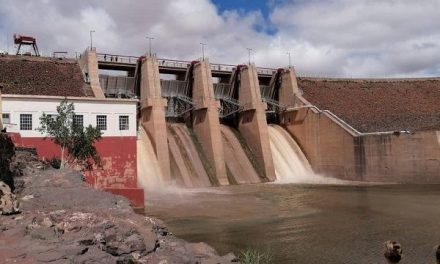
Weather overview and short-term outlook to Wednesday 23 December 2020

Visual: Inferred position of the Inter-Tropical Convergence Zone based on recorded rainfall in central Africa.
Source: Meteoblue.com
https://www.meteoblue.com/en/weather-maps/pretoria_south-africa_964137?variable=pcpprob01_pressure&level=surface&lines=none&mapcenter=-17.4764N60.8203&zoom=3
Recent Developments
For the past three days, a cyclonic system has remained stationery over northern and north-eastern Botswana. This system draws its moisture from the tropical zone over Zambia and the southern half of the DRC, as can be seen in the visual. What is obvious is that there is an enormous amount of moisture available at source and that only the technical development in the upper atmosphere over the next few days will determine how much of that system reaches Namibia.
This week’s visual was chosen because it clearly shows where the active part of the so-called Inter-tropical Convergence Zone lies. The northern boundary is currently over the Sahel stretching from the bulge of Africa in the west to the Ethiopian highlands in the east. This part of the ITCZ does not concern us very much since it is north of the equator.
What is important to Namibia is the current position of the ITCZ’s southern boundary and how much mobility it has over both the western part and the eastern part of the southern African sub-continent.
The cyclonic system over Botswana is very strong but only on the surface. In the synoptic charts of the middle layers of the atmosphere (15,000 to 30,000 feet) it is already noticeably weaker than near the ground. But it means that all the air that is drawn in from the north and the east must go somewhere, and that is up. The practical implication is that huge amounts of tropical moisture is advected aloft into the upper layers of the atmosphere. The question now is: Which way is this part of the atmosphere going to shift?
By Friday morning the core of the South Atlantic high pressure cell (1024 mB) was situated some one thousand kilometres off Saldanha Bay, smack on the latitude where it is expected. On the eastern side of the continent, high pressure presence was much subdued with the southern Indian high far out to sea, more or less in the middle of the Indian Ocean. This was also confirmed by the strong trough that flowed from the southern end of the Botswana system across northern South Africa and southern Mozambique.
However, the leading rim of the South Atlantic high (1016 mB) has just started its migration around Cape Agulhas, and will only reach the southern end of the Mozambican Channel late on Saturday. By Sunday, it will start moving up the Channel (northwards) and by Sunday night, it will recurve and enter the continent in southern Mozambique, causing the airflow to be predominantly zonal from east to west.
Since this constitutes high pressure control over the eastern part of the sub-continent, it has all the potential to move the system that is currently over Botswana into Namibian airspace but it is not known how far west this movement will be.
On the Radar
The feature to keep an eye on is the cyclonic system over Botswana.
Given the push from the higher pressures in the east, that system is expected to enter Namibia, more or less in the Kaudum/Tsumkwe area by Sunday afternoon.
It is then expected to grow stronger and remain over the area described by the line connecting Tsumkwe to Mururani to Oshivello to Outjo to Kalkfeld to Okakara to Otjinene and back to Tsumkwe.
This system is further expected to develop well-demarcated convergence zones, particularly to the south-east of the main system, which may bring widespread rains to the relevant areas of Otjozondjupa and Omaheke.
It is possible that by Tuesday, in the wake of a trough over the interior, this moisture may even reach the eastern halves of both Hardap and Karas.
By Wednesday, the system has departed and Namibia is back to hot days, mostly clear skies with only some intermittent cloud formation as a result of the lingering moisture.










































